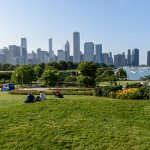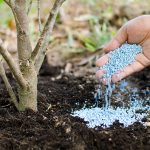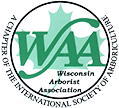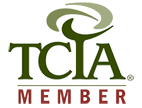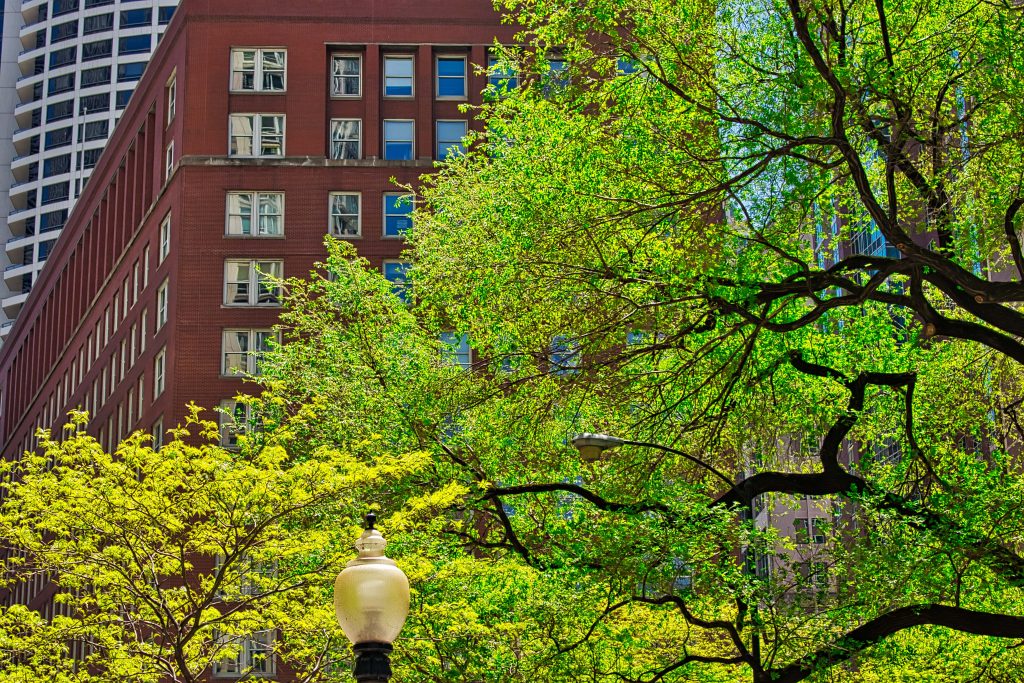
Learn more about some of the potential problems invasive tree species can cause throughout Chicagoland, IL
Learn more about some of the potential problems invasive tree species can cause throughout Chicagoland, IL
Early summer is a great time of year in the Chicago area. The trees are getting greener, and the weather is getting warmer as people throughout Chicagoland flock outside to enjoy the nice weather.
There are many ways to enjoy the summer in the Chicago area. One thing people like to do in the summer is spend time in nature and enjoy the plant and wildlife. Illinois is home to many different types of trees which we have covered in our blog series about the native trees of the Chicago area. However, there are also plenty of species of invasive trees that have found their way to Illinois and become a regular part of the landscape.
Invasive tree species may be planted as ornamental plants in yards and landscapes, but they can cause problems for the ecosystem when they appear in nature. Illinois residents should avoid planting non-native trees and plants in their landscapes to help maintain balance in the ecosystem and protect native plants and animals. This makes it important to be familiar with invasive tree species and how they can affect the native ecosystem.
In this guide, we will discuss the most common invasive tree species in Illinois, how they got here, and how they spread. These trees have come from different countries by various means and have detrimental effects on the native ecosystem. If you have one of these invasive trees in your yard, our arborists at Hendricksen Tree Care can remove it effectively with our full tree removal services.
Why are Invasive Plants a Problem?
Invasive plants are plants that have inhabited a geographical area outside of their native habitat. These plants developed in a particular ecosystem in which there are controls like insects and diseases that can keep their populations in check. When these plants appear in a different ecosystem, these natural controls are not there which allows the population of these plants to grow unchecked.
All ecosystems have a delicate balance that benefits plants and wildlife. Invasive trees and plants cause problems because they compete with native plants for nutrients. Invasive trees such as garlic mustard, Japanese honeysuckle, and buckthorns are aggressive and will choke out native plants. This is bad for native wildlife as well because the invasive plants don’t support the wildlife and they eliminate native plants that the wildlife depends on for food. Without the natural checks on invasive trees and plants, they can spread very quickly and crowd out native plants.
The Spread of Invasive Trees and Plants
If you plant an invasive tree or shrub in your yard, it is inevitable that the plant will spread. You can prune and maintain it meticulously, but there is very little you can do to stop the natural forces at work that allow a plant to spread to new areas. This is why it is important to avoid planting invasive trees, shrubs, and other plants in your yard.
Invasive trees and plants can spread easily in the following ways, especially with no natural controls:
- Birds and animals can spread the seeds of invasive plants by eating the fruit and spreading the seeds to new areas.
- Seeds of some invasive species can spread by water or wind.
- Some invasive plants have underground side stems that can grow into new plants.
- People continue to buy and plant invasive trees and plants in their landscapes which contributes to their spread.
Common Invasive Trees in Illinois
There are many invasive trees and plants that have found their way to the Chicago area. This is not a complete list of invasive trees but the most common and disruptive to the native ecosystem.
Tree of Heaven
Tree of heaven (Ailanthus altissima) is a tree native to China that looks similar to native hickory trees. Its slender leaves are the most defining characteristic, and it has large clusters of yellow flowers that bloom in the early summer. This plant is a threat because it can grow in poor soil conditions and displace native plants. They are likely to invade forests, fields, and meadows where they can spread very quickly.
Garlic Mustard
Garlic mustard (Alliaria petiolata) is a forb native to Europe that was brought to the U.S. to be used for culinary and medicinal purposes. It gets its name from the garlic aroma it gives off when part of the plant is crushed. Mature garlic mustard plants have triangular toothed leaves, and they produce small white flowers and slender, green seed pods. These plants are a threat because they can grow in dense stands on forest floors because of their high shade tolerance. They can also inhibit seed germination of native plants and trees with the allelopathic compounds they produce.
Autumn Olive
The autumn olive (Elaeagnus umbellata) is a shrub with thorny branches and leaves that are dotted silver on their undersides. They grow between 3 and 20 feet and they produce yellow, tubular flowers and round red drupes. This plant is native to China and Japan and it takes up open areas by growing in dense shrub layers that can crowd out native plants.
Chinese Privet
The Chinese privet (Ligustrum sinense) is a semi-evergreen small tree or shrub native to Asia and Europe. It has oblong leaves that grow in opposite patterns and cream-colored flowers that bloom in late spring. These plants also produce small round fruits in abundance that are dark purple or black when ripe. The Chinese privet is a problem because it can grow in dense thickets that shade out native understory plants and prevent the development of native trees.
Japanese Honeysuckle
Japanese honeysuckle (Lonicera japonica) is a woody, semi-evergreen vine with opposite, oval shaped leaves and showy tubular flowers that start whitish pink in color and turn cream colored. These vines can grow up to 80 feet upwards and they may girdle small trees or grow densely in tree canopies. They are native to eastern Asia and were originally introduced in the U.S. for ornamental planting and erosion control.
Amur Honeysuckle
Amur honeysuckle (Lonicera maackii) is a woody shrub with opposite oval shaped leaves and white flowers that grow in erect pairs. These plants can grow in stands that stop native shrubs and understory plants from forming, and birds can feed on their fruits well into the winter and spread their seeds. Amur Honeysuckle shrubs also leaf out faster than most native plats which gives them a competitive advantage.
Princess Tree
The princess tree (Paulownia tomentosa) is a medium sized tree native to China that resembles the native northern catalpa. These trees have large oval or heart-shaped leaves that are hairy on both sides and they have large, fragrant violet-pink flowers that grow in upright clusters. Princess trees are aggressive and will take over forests and other areas. They were brought to the U.S. from China as an ornamental plant.
Glossy Buckthorn
Glossy buckthorn (Frangula alnus) is a small tree native to Europe with grayish-brown bark and dark green leaves. It is a problem in Illinois because it grows quickly, produces a lot of seeds, and forms in dense thickets that can crowd out native shrubs, understory plants, and tree seedlings. The glossy buckthorn was brought to the U.S. as an ornamental plant.
European Buckthorn
The European buckthorn (Rhamnus cathartica), also known as the common buckthorn, is a small tree native to Europe. It has dark green oval leaves that can be in opposite or alternate arrangements and fragrant, yellow-green flowers that form in clusters of 2 to 6 flowers. These trees crowd out native shrubs and understory plants by growing in dense thickets and they are difficult to eliminate as they can regenerate after being cut or burned.
Black Locust
Black locust trees (Robinia pseudoacacia) are native to the Southern Appalachians and Ozarks, but they are invasive in the Midwest. These trees can grow to over 100 feet tall and they have light brown, furrowed bark, and small round leaflets. Their showy white and yellow flowers develop in long clusters about 8 inches long. Black locusts are problematic in the prairies and savannas of the Midwest because they can dominate and shade these open spaces.
Winged Burning Bush
The winged burning bush (Euonymus alatus) is a large shrub native to northeastern Asia. Its rounded leaves are dark green in the summer but turn crimson red and purple in the fall which is where it gets its name. These shrubs are a problem in Illinois because they can take over disturbed and undisturbed forested areas and displace native plants by growing in dense thickets. They can spread quickly because wildlife eats the fruits and disperses the seeds.
Callery Pear
The callery pear (Pyrus calleryana), also known as the Bradford pear, is a medium size tree with rounded leaves and showy white flowers. Its fruits are about half an inch and diameter and may appear greenish brown in color. The fruits produced by this tree are sterile because it does not self-pollinate. However, newer bred cultivars of this tree do produce fertile fruit that can cause the trees to seed out and invade new areas.
Tree Services from Hendricksen Tree Care
The above-mentioned invasive tree and plant species can do damage to the native plants and wildlife in Illinois and the Chicago area. The best way you can help is to not plant any invasive tree species in your yard or landscape. Even if you take attentive care of your plants and prune them often, there is little you can to do prevent the wind or animals from spreading the pollen or seeds that will cause them to grow in new places.
If you find that there is an invasive tree or plant in your yard, call our professional arborists to remove it. We provide complete tree removal that includes the felling and removal of the tree as well as stump grinding and removal. By avoiding planting non-native plants and having existing invasive plants removed, you can do your part to protect our native ecosystems of Illinois.
